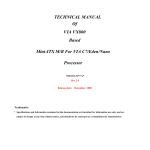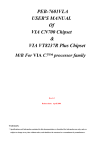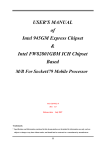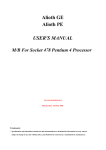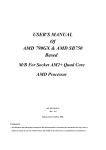Download USER'S MANUAL Of VIA CX700M Chipset Based
Transcript
USER'S MANUAL Of VIA CX700M Chipset Based M/B For VIA C7™ processor Family NO. G03-7F5-F Rev:4.0 Release date: Jan. 2008 Trademark: * Specifications and Information contained in this documentation are furnished for information use only, and are subject to change at any time without notice, and should not be construed as a commitment by manufacturer. Environmental Protection Announcement Do not dispose this electronic device into the trash while discarding. To minimize pollution and ensure environment protection of mother earth, please recycle. ii TABLE OF CONTENT USER’S NOTICE.....................................................................................................................iii MANUAL REVISION INFORMATION ..............................................................................iii ITEM CHECKLIST ................................................................................................................iii CHAPTER 1 INTRODUCTION OF MOTHERBOARD 1-1 FEATURE OF MOTHERBOARD ..........................................................................1 1-2 SPECIFICATION .....................................................................................................2 1-3 LAYOUT DIAGRAM & JUMPER SETTING ......................................................3 CHAPTER 2 HARDWARE INSTALLATION 2-1 HARDWARE INSTALLATION STEPS ................................................................5 2-2 CHECKING MOTHERBOARD'S JUMPER SETTING......................................5 2-3 GLOSSARY ...............................................................................................................6 2-3-1 SETTING CPU BUS CLOCK & MEMORY CLOCK JUMPER..........7 2-3-2 OVER CLOCK RUNNING .......................................................................7 2-4 INSTALL MEMORY ...............................................................................................8 2-5 EXPANSION CARDS...............................................................................................8 2-5-1 PROCEDURE FOR EXPANSION CARD INSTALLATION ...............9 2-6 CONNECTORS, HEADERS....................................................................................9 2-6-1 CONNECTORS ..........................................................................................9 2-6-2 HEADERS ...................................................................................................11 2-7 STARTING UP YOUR COMPUTER .....................................................................17 CHAPTER 3 INTRODUCING BIOS 3-1 ENTERING SETUP ..................................................................................................18 3-2 GETTING HELP.......................................................................................................18 3-3 THE MAIN MENU ...................................................................................................19 3-4 STANDARD CMOS FEATURES............................................................................20 3-5 ADVANCED BIOS FEATURES .............................................................................21 3-6 ADVANCED CHIPSET FEATURES .....................................................................22 3-6-1 DRAM TIMING SETTING.......................................................................23 3-6-2 VGA TIMING SETTINGS ........................................................................23 3-6-3 PCI TIMING SETTINGS ..........................................................................24 3-7 INTEGRATED PERIPHERALS .............................................................................24 3-7-1 ONCHIP IDE FUNCTION ........................................................................25 3-7-2 ONCHIP DEVICE FUNCTION................................................................26 3-7-3 ONBOARD SUPER IO FUNCTION ........................................................26 3-8 POWER MANAGEMENT SETUP .........................................................................27 3-8-1 WAKE UP EVENTS...................................................................................28 3-9 PNP/PCI CONFIGURATION SETUP....................................................................28 3-10 PC HEALTH STATUS............................................................................................29 3-11 MISCELLANEOUS CONTROL............................................................................30 3-12 LOAD STANDARD/OPTIMIZED DEFAULTS ..................................................30 3-13 SET SUPERVISOR/USER PASSWORD ..............................................................31 CHAPTER 4 DRIVER & FREE PROGRAM INSTALLATION MAGIC INSTALL SUPPORTS WINDOWS 95/98/98SE/NT4.0/2000/XP ...................32 4-1 VIA 4 IN 1 INSTALL VIA SERVICE PACK 4 IN 1 DRIVER ............................33 4-2 VGA INSTALL VIA CX700M VGA DRIVER ...........................................34 4-3 SOUND INSTALL VIA HD AUDIO DRIVER ................................................35 4-4 LAN INSTALL VIA LAN CONTROLLER DRIVER ................................36 4-5 USB2.0 INSTALL VIA USB2.0 DEVICE DRIVER........................................36 4-6 RAIDDISK INSTALL VIA SATA RAIDDISK DRIVER .....................................37 4-7 PC-CILLIN INSTALL PC-CILLIN 2007 ANTI-VIRUS PROGRAM ...................37 4-8 PC-HEALTH INSTALL MYGUARD HARDWARE MONITOR UTILITY ...........38 4-9 CAPTURE INSTALL UNICHROME PRO VIDEO-IN CAPTURE DRIVER .....39 4-10 HOW TO UPDATE BIOS ........................................................................................41 ii USER’S NOTICE COPYRIGHT OF THIS MANUAL BELONGS TO THE MANUFACTURER. NO PART OF THIS MANUAL, INCLUDING THE PRODUCTS AND SOFTWARE DESCRIBED IN IT MAY BE REPRODUCED, TRANSMITTED OR TRANSLATED INTO ANY LANGUAGE IN ANY FORM OR BY ANY MEANS WITHOUT WRITTEN PERMISSION OF THE MANUFACTURER. THIS MANUAL CONTAINS ALL INFORMATION REQUIRED TO USE THIS MOTHER-BOARD AND WE DO ASSURE THIS MANUAL MEETS USER’S REQUIREMENT BUT WILL CHANGE, CORRECT ANY TIME WITHOUT NOTICE. MANUFACTURER PROVIDES THIS MANUAL “AS IS” WITHOUT WARRANTY OF ANY KIND, AND WILL NOT BE LIABLE FOR ANY INDIRECT, SPECIAL, INCIDENTIAL OR CONSEQUENTIAL DAMAGES (INCLUDING DAMANGES FOR LOSS OF PROFIT, LOSS OF BUSINESS, LOSS OF USE OF DATA, INTERRUPTION OF BUSINESS AND THE LIKE). PRODUCTS AND CORPORATE NAMES APPEARING IN THIS MANUAL MAY OR MAY NOT BE REGISTERED TRADEMARKS OR COPYRIGHTS OF THEIR RESPECTIVE COMPANIES, AND THEY ARE USED ONLY FOR IDENTIFICATION OR EXPLANATION AND TO THE O;WNER’S BENEFIT, WITHOUT INTENT TO INFRINGE. Manual Revision Information Reversion 4.0 Revision History Fourth Edition Date Jan. 2008 Item Checklist 5 5 5 5 □ □ □ □ □ □ Motherboard Cable for IDE CD for motherboard utilities Users’ Manual Cable for COM Serial Port (Option) Cable for IEEE1394 (Option) Cable for USB2.0 (Option) Cable for TV-Out (Option)( support HDTV up to 1080i) Cable for LVDS (Option) Cable for Video-In (Option) iii Chapter 1 Introduction of VIA CX700M Chipset Motherboards 1-1 Feature of motherboard The VIA CX700M Chipset motherboard series are designed for the new generation VIA C7™ processor family with the VIA CX700M Chipset that delivers a high performance and professional desktop platform solution. The VIA CX700M is fully optimized to provide an outstanding HD digital media experience. The VIA CX700M Chipset motherboard series utilize the newest VIA CX700M chipset which supports 400MHz/ 533MHz System Bus in data transfer rate. The VIA CX700M Chipset motherboard series feature robust shared memory architecture and provide 266MHz/200MHz Memory clock frequency for DDR2 533/400 system RAM Modules which is expandable to 1.0GB. The single chipset offers ULTRA ATA 133 and Serial ATA2 with RAID 0, 1 function to provide speedier HDD throughout that boosts overall system performance. The VIA CX700M Chipset motherboard series implement the VIA VT6122 PCI LAN chip Support Fast Ethernet LAN function provide 10/100/1000 Mb/s data transfer rate. The integrated new VIA C7® processor is the smallest, lowest power, most efficient and most secure native x86 processor in the world. Built on the advanced VIA CoolStream™ architecture, the 'Esther'core of the VIA C7 processor is designed to extend the digital lifestyle by combining robust performance of up to 2.0GHz with ultra low power consumption and highly efficient heat dissipation. The motherboard series also have an integrated 6-channel High Definition Audio Codec on board which is fully compatible with Sound Blaster Pro® that offers you with home cinema quality and absolutely software compatibility. The VIA CX700M Chipset motherboard series integrated the VIA Graphics UniChrome™ Pro II IGP graphics core features the Chromotion™ video engine raising the bar for digital entertainment support on PC systems. The Chromotion™ video engine employs a multi-faceted approach to displaying multimedia content, implementing a number of advanced tools at every stage of video processing including MPEG-2, MPEG-4, and WMV9 decoding, and advanced rendering tools such as Adaptive De-Interlacing and Video Deblocking, which ensure clearer playback of digital content on all display devices. The VIA CX700M also provides extensive display support with outputs to CRT, LCD and standard definition TV as well as support for TV up to 1080i resolution. Embedded USB and optional VIA 6307S IEEE1394 controllers as well as capability of expanding to 6 of USB 2.0 functional ports and 1 of IEEE1394 9-pin block delivering 480Mb/s and 400 Mb/s bandwidth of rich connectivity, these motherboards meet the future USB demands which are also equipped with hardware monitor function on system to monitor and protect your system and maintain your non-stop business computing. The motherboards provide reliable performance & meets mainstream specification of MCE related concepts. It is really a cost effective choice for your computer. 1 1-2 Specification Spec Description Design Chipset CPU ∗ ∗ ∗ Memory Socket ∗ 240-pin DDR2 DIMM socket x1 ∗ Support DDR2 533/400 system RAM Modules DDR memory ∗ Expandable to 1GB ∗ 32-bit PCI slot x 1pcs ∗ Integrated UniChrome Pro II 3D / 2D Graphics & Video Processor Unified Video Decoding Accelerator ∗ Integrated TV Encoder ∗ Support MPEG-2,MPEG-4,WMV9 ∗ Two PCI IDE controllers support PCI Bus Mastering, ATA PIO/DMA and the ULTRA DMA 33/66/100/133 functions that deliver the data transfer rate up to 133 MB/s; Two Serial ATA2 ports provide 300 MB/sec data transfer rate for two Serial ATA2 Devices and offer RAID 0, 1 functions ∗ Integrated VIA VT6122 LAN-PHY Controller ∗ Support 10/100/1000 BASE-T Transfer rate ∗ VIA VT1708A High Definition Audio controller integrated ∗ 6-channel High Definition Audio CODEC onboard ∗ Audio driver and utility included ∗ Award 4Mb Flash ROM ∗ PS/2 keyboard and PS/2 mouse connectors ∗ VGA Connector x1 ∗ DVI Connector x1 (J7F5M-VDE series only) ∗ HDMI Connector x1 (J7F5M-VHE series only) ∗ TV-OUT header x1 (Option) ∗ Video –In header x1 ∗ COM Port header x2 ∗ LVDS header x1 (J7F5M-VLE series only) ∗ LVDS Inverter header x1 (J7F5M-VLE series only) ∗ USB 2.0 connector x2 ∗ USB 2.0 headers x2 (connecting cable option) ∗ Audio connector (Line-in, Line-out, MIC) Expansion Slot Integrate VGA Integrate IDE and Serial ATAII RAID Integrate LAN Audio BIOS Multi I/O 1394 (Optional) ∗ ∗ Mini ITX form factor 6 layers PCB size: 17.0x17.0cm VIA CX700M Chipset Embedded VIA C7 , VIAC7-D,VIA EDEN processor Integrated VIA VT6307S 1394 controller Compliant with IEEE 1394a-2000 standard, support 400Mbit/s data transfer rate. 2 1-3 Layout Diagram & Jumper Setting VGA LAN Optional HDMI PS/2 MOUSE LINE-IN Optional 1394 PS/2 Keyboard Optional DVI USB LINE-OUT MIC JP4 USB/KB/MS Power ON Jumper (JP2) IR ATX Power Connector CPU FAN PS2 KB/Mouse Port VGA / DVI Connector VIA C7 EBGA CPU COM1 Optional TV-OUT Optional LVDS Optional LVDS Invert JP5 USB Port/LAN Connector SFAN1 HDMI VIA CX700M Chip VIA VT1708A Chip DIMM Socket X1 COM2 VIA VT6122 PHY Controller ATA 133 IDE Conn. Audio Jack Speaker/Power LED Connector Optional 1394 1394 header CD Audio CDIN PCI Slot Video-IN Daughter Board Expansion Connector SFAN2 Front Panel Connector SATA Connector (SATA1, SATA2) Clear CMOS (JBAT) USB Power ON Jumper (JP3) USB Port (USB1/USB2) 3 Jumpers Jumper JP2 JP4 JBAT JP3 Name Keyboard /USB Power ON Function Setting PVDD Function Setting CMOS RAM Clear Function Setting USB Power On Function Setting Description 3-pin Block Page p.6 3-pin Block 3-pin Block 3-pin Block p.6 p.6 p.6 Connectors Connector ATXPWR KB/MS1 UL1 VGA Line-In/Out, MIC Name ATX Power Connector PS/2 Mouse & PS/2 Keyboard Connector USB/ LAN Port Connector VGA Port Connector Line-Out/Line-In/MIC Audio Connector Description 24-pin Block 6-pin Female 4-pin Connector 15-pin Female Phone Jack Page p.9 p.10 p.10 p.10 p.10 1394(Option) IDE1 1394 Port1 Connector Primary/Secondary Connector 9-pin Connector 40-pin Block p.10 p.10 DVI(J7F5M –VDE ) Digital Video Interface Connector 24-pin Connector High Definition Media Interface Connector 20-pin Connector Serial ATA IDE Connector 7-pin Connector p.11 p.11 p.11 Name COM2 Serial Port Headers Line-Out/MIC output Header USB2.0 Port Headers 1394 Port2 Headers Hard drive LED connector Reset switch lead Speaker connector Power LED Headers Power Button Headers FAN Speed Headers CD Audio-In Headers LVDS Connector header LVDS Inverter Connector Description 10-pin Block 4-pin Block 10-pin Block 9-pin Block 3-pin Block 2-pin Block 4-pin Block 2-pin Block 2-pin Block 3-pin Block 4-pin Block 32-pin Block 7-pin Block Page p.11 p.11 p.12 p.12 p.12 p.12 p.12 p.13 p.13 p.13 p.13 p.14 p.14 TV-OUT header Infra-red header PCI Adapter Headers Video-In header 9-pin Block 5-pin Block 120-pin Block 6-pin header p.14 p.15 p.13 p.13 HDMI(J7F5M-VHE) SATA1/2 Headers Header COM1/COM2 AUDIO USB1/USB2 1394B1(Option) HD_LED RESET SPEAK PWR LED PWR BTN CPUFAN, SFAN1/2 CDIN LVDS(J7F5M-VLE) LVDS Inverter (J7F5M-VLE) TV-OUT(Option) IR CN1/CN2 Video-In Expansion Sockets Socket/Slot DDR2 PCI1 Name Description DDR2 SDRAM Module 240-pin DDR2 SDRAM Module Socket Expansion Socket PCI Slot 32-bit PCI Local Bus Expansion slots 4 Page p.8 p.8 Chapter 2 Hardware installation 2-1 Hardware installation Steps Before using your computer, you had better complete the following steps: 1. Check motherboard jumper setting 2. Install CPU and Fan 3. Install System Memory (DIMM) 4. Install Expansion cards 5. Connect IDE, Front Panel /Back Panel cable 6. Connect ATX Power cable 7. Power-On and Load Standard Default 8. Reboot 9. Install Operating System 10. Install Driver and Utility 2-2 (1) Checking Motherboard’s Jumper Setting USB Power On function Enabled/Disabled (3-pin): JP3 When setting Enabled you can use USB Device to power on system. 1 JP3 1-2 closed USB Power On Disabled (Default) 3 1 JP3 2-3 closed USB Power On Enabled 3 (2) CMOS RAM clears (3-pin): JBAT A battery must be used to retain the motherboard configuration in CMOS RAM short 1-2 pins of JPAT to store the CMOS data. To clear the CMOS, follow the procedure below: 1. Turn off the system and unplug the AC power 2. Remove ATX power cable from ATX power connector 3. Locate JBAT and short pins 2-3 for a few seconds 4. Return JBAT to its normal setting by shorting pins 1-2 5. Connect ATX power cable back to ATX power connector Note: When should clear CMOS 1. Troubleshooting 2. Forget password 3. After over clocking system boot fail 5 1 1 JBAT JBAT 3 1-2 closed 3 2-3 closed Normal (Default) Clear CMOS CMOS RAM Clear Setting (3) LVDS Function Setting (3-pin): JP4/JP5 JP4 JP4 1 1 3 1-2 closed 3 5V Power for Backlight 2-3 closed J5 1 J5 1 3 1-2 closed 3.3V Power for Backlight 3 LVDS Backlight Enable 2-3 LVDS Backlight Disable LVDS Function Setting (4) Keyboard Power On function Enabled/Disabled (3-pin): JP2 When setting Enabled you can using keyboard by key in password to power on system. JP2 JP2 1 3 3 1-2 closed (Default) 1 K/B Power ON Disable 2-3 closed K/B Power ON Enabled Keyboard Power On Setting 2-3 Glossary Chipset (core logic) - two or more integrated circuits which control the interfaces between the system processor, RAM, I/O devises, and adapter cards. Processor socket - the socket used to mount the system processor on the motherboard. Slot (PCI, RAM) - the slots used to mount adapter cards and system RAM. PCI - Peripheral Component Interconnect - a high speed interface for video cards, sound cards, network interface cards, and modems; runs at 33MHz. Serial Port - a low speed interface typically used for mouse and external modems. PS/2 - a low speed interface used for mouse and keyboards. USB - Universal Serial Bus - a medium speed interface typically used for mouse, keyboards, scanners, and some digital cameras. Sound (interface) - the interface between the sound card or integrated sound connectors and speakers, MIC, game controllers, and MIDI sound devices. BIOS (Basic Input/Output System) - the program logic used to boot up a computer and establish the relationship between the various components. Driver - software, which defines the characteristics of a device for use by another device or 6 other software. Processor - the "Central Processing Unit" (CPU); the principal integrated circuit used for doing the "computing" in "personal computer" Front Side Bus Frequency - The working frequency of the motherboard, which is generated by the clock generator for CPU, DRAM and PCI BUS. CPU L2 Cache - The flash memory inside the CPU, normally Pentium III CPU has 256K or above, while Celeron CPU will have 128K. 2-3-1 Setting CPU Bus Clock & Memory Clock Jumper Setting the front side bus frequency and SDRAM frequency The motherboard uses jumper less function for the front side bus frequency and SDRAM frequency users don’t need setting any jumper when plug the CPU in motherboard For experience user looking for over clocking possibility, please refer to sec 2-3-2. 2-3-2 Over clock Running WARNING! This section is for experienced motherboard installer only. Over clocking can result in system instability or even shortening life of the processor. Users can choose over clock running by BIOS CMOS SETUP UTILITY. When you entered CMOS SETUP UTILITY, choose “Miscellaneous Control” you will see the screen as below then. Phoenix – AwardBIOS CMOS Setup Utility Miscellaneous Control Auto Detect PCI Clock Spread Spectrum CPU Clock Ratio ** Current Host Clock Host Clock at Next Boot ** Current DRAM CLOCK DRAM Clock at Next Boot 1.5VSUS Select Vccp Select Vcc1.5 Select VDIMM Select Flash Part Write Protect Enabled Disabled 15x 100MHZ 100MHZ 266MHz ** 266MHz(By SPD) 1.50(Default) 1.05(Default) 1.50(Default) 1.90V(Default) Disabled Item Help Menu Level > ↑↓→← Move Enter:Select Item +/-/PU/PD:Value F10:Save ESC:Exit F1:General Help F5:Previous Values F6:Optimized Defaults F7:Standard Defaults WARNING! The Design of this motherboard follows chipset and CPU vender’s design guideline. Any attempts to push beyond product specification are not recommended and you are taking your own risk to damage your system or important data. Before over clocking, you must make sure your components are able to tolerate such abnormal setting, especially CPU, memory, hard disks, and VGA cards. 7 2-4 Install Memory The motherboards provide one 240-pin DUAL INLINE MEMORY MODULES (DIMM) sites for memory expansion available from minimum memory size of 64MB to maximum memory size of 1.0GB DDR2 SDRAM. Valid Memory Configurations Bank Bank 0, 1 (DDR1) Total 240-Pin DIMM PCS Total Memory DDR2 533/DDR2 400 DDR2 SDRAM Module X1 64MB∼1.0GB 1 64MB∼1.0GB System Memory (Max. 1.0GB) DIMM1 (BANK0+BANK1) Generally, installing DDR SDRAM modules to your motherboard is very easy, you can refer to figure 2-4 to see what a 240-Pin DDR2 400/DDR2 533 DDR2 SDRAM module looks like. Figure 2-4 NOTE! When you install DIMM module fully into the DIMM socket the eject tab should be locked into the DIMM module very firmly and fit into its indention on both sides. WARNING! For the DDR SDRAM CLOCK is set at 133MHz, use only DDR266-compliant DDR Modules. When this motherboard operate at 133MHz, most system will not even boot if non-compliant modules are used because of the strict timing issues, if your SDR Modules are not DDR266-compliant, set the DDR SDRAM clock to 100MHz to ensure system stability. 2-5 Expansion Cards WARNING! Turn off your power when adding or removing expansion cards or other system components. Failure to do so may cause severe damage to both your motherboard and expansion cards. 8 2-5-1 Procedure For Expansion Card Installation 1. Read the documentation for your expansion card and make any necessary hardware or software setting for your expansion card such as jumpers. 2. Remove your computer’s cover and the bracket plate on the slot you intend to use. 3. Align the card’s connectors and press firmly. 4. Secure the card on the slot with the screen you remove above. 5. Replace the computer system’s cover. 6. Set up the BIOS if necessary. 7. Install the necessary software driver for your expansion card. 2-6 Connectors, Headers 2-6-1 Connectors (1) Power Connector (24-pin block) : ATXPWR ATX Power Supply connector: This is a new defined 24-pins connector that usually comes with ATX case. The ATX Power Supply allows to use soft power on momentary switch that connect from the front panel switch to 2-pins Power On jumper pole on the motherboard. When the power switch on the back of the ATX power supply turned on, the full power will not come into the system board until the front panel switch is momentarily pressed. Press this switch again will turn off the power to the system board. ** We recommend that you use an ATX 12V Specification 2.0-compliant power supply unit (PSU) with a minimum of 80W power rating. This type has 24-pin and 4-pin power plugs. ** If you intend to use a PSU with 20-pin and 4-pin power plugs, make sure that the 20-pin power plug can provide at least 6.6A on +12V and the power supply unit has a minimum power rating of 80W. The system may become unstable or may not boot up if the power is inadequate. ROW1 ROW2 PIN ROW1 ROW2 Pin 1 Pin 1 20-Pin 24-Pin 9 ROW1 ROW2 1 3.3V 3.3V 2 3.3V -12V 3 GND GND 4 5V Soft Power On 5 GND GND 6 5V GND 7 GND GND 8 Power OK -5V 9 +5V (for Soft Logic) +5V 10 +12V +5V 11 +12V +5V 12 +3V GND (2) PS/2 Mouse & PS/2 Keyboard Connector: KB/MS1 If you are using a PS/2 mouse, you must purchase an optional PS/2 mouse set which connects to the 5-pins block and mounts to an open slot on your computer’s case. (3) USB Port connector: UL1 The connectors are 4-pins connector that connect USB devices to the system board, and standard RJ45 connector for Network supports 10/100 BASE-T transfer rate. (4) VGA Connector (15-pin female): VGA VGA Connector is a 15-pin D-Subminiature Receptacle connector. This connector is for connection Monitor and System to display. (5) Audio Connector: (Line-Out/ Line-IN/ MIC) This Connector are 3 phone Jack for LINE-OUT/ LINE-IN/ MIC. Line-out : Audio output to speaker Line-In : Audio input to Audio controller MIC : Microphone Connector (6) 1394 Port1 Connector: 1394 (Option) (7) Primary IDE Connector (40-pin block): IDE1 This connector supports the provided IDE hard disk ribbon cable. After connecting the single plug end to motherboard, connect the two plugs at other end to your hard disk(s). If you install two hard disks, you must configure the second drive to Slave mode by setting its jumpers accordingly. Please refer to the documentation of your hard disk for the jumper settings. IDE1 Pin 1 • Two hard disks can be connected to each connector. The first HDD is referred to as the “Master” and the second HDD is referred to as the “Slave”. 10 • For performance issues, we strongly suggest you don’t install a CD-ROM or DVD-ROM drive on the same IDE channel as a hard disk. Otherwise, the system performance on this channel may drop. (8) Serial-ATA Port connector: SATA1 / SATA2 This connector supports the provided Serial ATA IDE hard disk cable to connecting the motherboard and serial ATA hard disk. DVI: Digital Visual Interface (Option) This interface standard designed to maximize the visual quality of digital display devices such as flat panel LCD computer displays and digital projectors. (10) HDMI: High-Definition Multimedia Interface (Option) This point-to-point interface is for audio and video signals designed as a single-cable solution for home theater and consumer electronics equipment. (9) 2-6-2 Headers (1) COM1/COM2 Serial Port Headers (9-pin) : COM1/COM2 This board has two serial ports COM1/COM2 (Headers), it come with cable providing serial port COM1/COM2. The On-board serial port can be disabled through BIOS SETUP. Please refer to Chapter 3 “INTEGRATED PERIPHERALS SETUP” section for more detail information. Pin 1 COM1 Note: Orient the read marking on the COM1/2 ribbon cable to pin 1 Pin 1 COM2 (2) Line-Out, MIC Header (9-pin): AUDIO This header connects to Front Panel Line-out, MIC connector with cable. 11 AUD-RET-L AUD-GND AUD-VCC AUD-RET-R AUDIO 2 10 Pin 1 AUD-MIC AUD-MIC-BIAS AUD-FPOUT-R HP-ON AUD-FPOUT-L 9 Line-Out, MIC Headers +DATA GND OC VCC -DATA VCC +DATA GND -DATA +DATA GND Pin 1 VCC Pin 1 -DATA +DATA GND OC USB2 -DATA USB1 VCC (3) USB Port Headers (9-pin) : USB1/ USB2 These headers are used for connecting the additional USB port plug. By attaching an option USB cable, your can be provided with two additional USB plugs affixed to the back panel. USB Port Headers GND TPBVCC GND 1394B TPA- (4) 1394 Port B Headers (9-pin) : 1394 (Option) TPA+ GND TPB+ VCC Pin 1 1394 Port 2 Headers (5) IDE Activity LED: HD_LED This connector connects to the hard disk activity indicator light on the case. (6) Reset switch lead: RESET This 2-pin connector connects to the case-mounted reset switch for rebooting your computer without having to turn off your power switch. This is a preferred method of rebooting in order to prolong the lift of the system’s power supply. See the figure below. (7) Speaker connector: SPEAK This 4-pin connector connects to the case-mounted speaker. See the figure below. 12 GND PWRBT GND PWRBTN PWR LED PWRLE PWRLED HLED+ HLED- JW FP PWRLED SPEAK Pin 1 SPKR NC GND VCC5 HDLED RESET RST NC Pin 1 System Case Connections (8) Power LED: PWR LED The Power LED is light on while the system power is on. Connect the Power LED from the system case to this pin. (9) Power switch: PWR BTN This 2-pin connector connects to the case-mounted power switch to power ON/OFF the system. (10) FAN Speed Headers (3-pin) : CPUFAN, SFAN1/SFAN2 These connectors support cooling fans of 350mA (4.2 Watts) or less, depending on the fan manufacturer, the wire and plug may be different. The red wire should be positive, while the black should be ground. Connect the fan’s plug to the board taking into consideration the polarity of connector. 1 3 CPUFAN 1 SFAN1 3 3 1 SFAN2 (11) CD Audio-In Headers (4-pin): CDIN CDIN is the connectors for CD-Audio Input signal. Please connect it to CD-ROM CD-Audio output connector. CDIN 1 4 CD Audio-In Headers (12) Expansion Daughter Board Headers: CN1/CN2 13 You can purchase additional daughter boards like the COM Port card/ LAN card/ PCMCIA card./ MINI-PCI card from Jetway to install in these headers. CN1 Pin 1 CN2 Pin 1 Expansion Daughter Board Headers (13) TV-OUT Header (Option) TV-OUT is the 9-pin block pin-header. TV-out is commonly used to label the connector of equipment offering an analog video signal that is acceptable for a HD television AV input. Pin1 TVGND TVGND SPCLK1 TV_COMP SPD1 Y_SVHS C_SVHS VCC HDTV-OUT Conn. 9-pin Block (14) LVDS Pin-Headers: LVDS (Option) These Headers can connect with the LVDS devices. 14 PIN No. Symbol PIN NO. Symbol 1 R2IN3- 2 R2IN3+ 3 CK2IN- 4 CK2IN+ 5 R2IN2- 6 R2IN2+ 7 R2IN1- 8 R2IN1+ 9 R2IN0- 10 R2IN0+ 11 GND 12 GND 13 GND 14 GND 15 GND 16 GND 17 R1IN3+ 18 R1IN3- 19 CK1IN- 20 CK1IN+ 21 R1IN2+ 22 R1IN2- 23 R1IN1+ 24 R1IN1- 25 R1IN0+ 26 R1IN0- 27 VDD 28 VDD 29 VDD 30 VDD 29 GND 30 GND (15) Pin-headers of LVDS Inverter: LVDS (Option) (16)IR Headers (9-pin): IR-compliance pin-headers IR Pin 1 IR Headers 15 (17) Optional Expansion cards Expansion Daughter-boards (optional) AD2COM For 2xCOM Ports Added ADRTLAN-P/ADRTLAN-G For 2nd 10/100 or 10/100/1000 Ethernet LAN ADPCM Card Bus Type I + II Supported Expansion Interface With CF Compatible Card Reader 16 ADCF IDE Interface Supported CF Compatible Disk On Module 2-7 Starting Up Your Computer 1. After all connections are made, close your computer case cover. 2. Be sure all the switch are off, and check that the power supply input voltage is set to proper position, usually in-put voltage is 220V∼240V or 110V∼120V depending on your country’s voltage used. 3. Connect the power supply cord into the power supply located on the back of your system case according to your system user’s manual. 4. Turn on your peripheral as following order: a. Your monitor. b. Other external peripheral (Printer, Scanner, External Modem etc…) c. Your system power. For ATX power supplies, you need to turn on the power supply and press the ATX power switch on the front side of the case. 5. The power LED on the front panel of the system case will light. The LED on the monitor may light up or switch between orange and green after the system is on. If it complies with green standards or if it is has a power standby feature. The system will then run power-on test. While the test is running, the BIOS will alarm beeps or additional message will appear on the screen. If you do not see any thing within 30 seconds from the time you turn on the power. The system may have failed on power-on test. Recheck your jumper settings and connections or call your retailer for assistance. Beep Meaning One short beep when displaying logo No error during POST Long beeps in an endless loop No DRAM install or detected One long beep followed by three short beeps Video card not found or video card memory bad High frequency beeps when system is working CPU overheated System running at a lower frequency 6. During power-on, press <Delete> key to enter BIOS setup. Follow the instructions in BIOS SETUP. 7. Power off your computer: You must first exit or shut down your operating system before switch off the power switch. For ATX power supply, you can press ATX power switching after exiting or shutting down your operating system. If you use Windows 9X, click “Start” button, click “Shut down” and then click “Shut down the computer?” The power supply should turn off after windows shut down. 17 Chapter 3 Introducing BIOS The BIOS is a program located on a Flash Memory on the motherboard. This program is a bridge between motherboard and operating system. When you start the computer, the BIOS program will get control. The BIOS first operates an auto-diagnostic test called POST (power on self test) for all the necessary hardware, it detects the entire hardware device and configures the parameters of the hardware synchronization. Only when these tasks are completed done it gives up control of the computer to operating system (OS). Since the BIOS is the only channel for hardware and software to communicate, it is the key factor for system stability, and in ensuring that your system performance as its best. In the BIOS Setup main menu of Figure 3-1, you can see several options. We will explain these options step by step in the following pages of this chapter, but let us first see a short description of the function keys you may use here: • Press <Esc> to quit the BIOS Setup. • Press ↑ ↓ ← → (up, down, left, right) to choose, in the main menu, the option you want to confirm or to modify. • Press <F10> when you have completed the setup of BIOS parameters to save these parameters and to exit the BIOS Setup menu. • Press Page Up/Page Down or +/– keys when you want to modify the BIOS parameters for the active option. 3-1 Entering Setup Power on the computer and by pressing <Del> immediately allows you to enter Setup. If the message disappears before your respond and you still wish to enter Setup, restart the system to try again by turning it OFF then ON or pressing the “RESET” button on the system case. You may also restart by simultaneously pressing <Ctrl>, <Alt> and <Delete> keys. If you do not press the keys at the correct time and the system does not boot, an error message will be displayed and you will again be asked to Press <F1> to continue, <Ctrl-Alt-Esc> or <Del> to enter Setup 3-2 Getting Help Main Menu The on-line description of the highlighted setup function is displayed at the bottom of the screen. Status Page Setup Menu/Option Page Setup Menu Press F1 to pop up a small help window that describes the appropriate keys to use and the possible selections for the highlighted item. To exit the Help Window, press <Esc>. 18 3-3 The Main Menu Once you enter Award® BIOS CMOS Setup Utility, the Main Menu (Figure 3-1) will appear on the screen. The Main Menu allows you to select from fourteen setup functions and two exit choices. Use arrow keys to select among the items and press <Enter> to accept or enter the sub-menu. Phoenix – AwardBIOS CMOS Setup Utility Standard CMOS Features Miscellaneous Control Advanced BIOS Features Load optimized Defaults Advanced Chipset Features Load Standard Defaults Integrated Peripherals Set Supervisor Password Power Management Setup Set User Password PnP/PCI Configurations Save & Exit Setup PC Health Status Exit Without Saving Esc : Quit ↑↓→← : Select Item F10 : Save & Exit Setup Time, Date, Hard Disk Type… Figure 3-1 Standard CMOS Features Use this Menu for basic system configurations. Advanced BIOS Features Use this menu to set the Advanced Features available on your system. Advanced Chipset Features Use this menu to change the values in the chipset registers and optimize your system’s performance. Integrated Peripherals Use this menu to specify your settings for integrated peripherals. Power Management Setup Use this menu to specify your settings for power management. PnP/PCI configurations This entry appears if your system supports PnP/PCI. PC Health Status This entry shows your PC health status. Miscellaneous Control Use this menu to specify your settings for Miscellaneous Control. Load Optimized Defaults Use this menu to load the BIOS default values that are factory settings for optimal performances system operations. Load Standard Defaults Use this menu to load the BIOS default values for the minimal/stable performance system operation. Set Supervisor/User Password Use this menu to set User and Supervisor Passwords. Save & Exit Setup 19 Save CMOS value changes to CMOS and exit setup. Exit Without Saving Abandon all CMOS value changes and exit setup. 3-4 Standard CMOS Features The items in Standard CMOS Setup Menu are divided into several categories. Each category includes no, one or more than one setup items. Use the arrow keys to highlight the item and then use the <PgUp> or <PgDn> keys to select the value you want in each item. Phoenix – AwardBIOS CMOS Setup Utility Standard CMOS Features Date (mm:dd:yy) Time (hh:mm:ss) IDE IDE IDE IDE Channel Channel Channel Channel 0 0 1 1 Thu, Nov, 27 2003 16 : 18 : 49 Master Slave Master Slave Video Halt On Base Memory Extended Memory Total Memory Item Help Menu Level > Change the day, month, Year and century EGA/VGA All Errors 640K 64512K 65536K ↑↓→← Move Enter:Select Item +/-/PU/PD:Value F10:Save ESC:Exit F1:General Help F5:Previous Values F6:Optimized Defaults F7:Standard Defaults Date The date format is <day><month><date><year>. Day Day of the week, from Sun to Sat, determined by BIOS. Read-only. The month from Jan. through Dec. Month The date from 1 to 31 can be keyed by numeric function keys. Date The year depends on the year of the BIOS. Year Time The time format is <hour><minute><second>. IDE Channel 0 Master/ Slave IDE Channel 1 Master/ Slave Press PgUp/<+>or PgDn/<–>to select Manual, None, Auto type. Note that the specifications of your drive must match with the drive table. The hard disk will not work properly if you enter improper information for this category. If your hard disk drive type is not matched or listed, you can use Manual to define your own drive type manually. If you select Manual, related information is asked to be entered to the following items. Enter the information directly from the keyboard. This information should be provided in the documentation from your hard disk vendor or the system manufacturer. If the controller of HDD interface is SCSI, the selection shall be “None”. If the controller of HDD interface is CD-ROM, the selection shall be “None” Access Mode The settings are Auto Normal, Large, and LBA. number of cylinders Cylinder number of heads Head write precomp Precomp Landing Zone landing zone number of sectors Sector 20 3-5 Advanced BIOS Features Phoenix – AwardBIOS CMOS Setup Utility Advanced BIOS Features Virus Warning CPU L1&L2 Cache CPU L2 Cache ECC Checking Quick Power On Self Test CPU Feature Hard Disk Boot Priority First Boot Device Second Boot Device Third Boot Device Boot Other Device Boot Up NumLock Status Typematic Rate Setting Typematic Rate (Chars/Sec) Typematic Delay (Msec) Security Option MPS Version Control For OS OS Select For DRAM > 64MB HDD S.M.A.R.T. Capability Video BIOS Shadow Disabled Enabled Disabled Enabled Press Enter Press Enter CDROM HDD-0 CDROM Enabled On Disabled 6 250 Setup 1.4 Non-OS2 Disabled Enabled Item Help Menu Level > ↑↓→← Move Enter:Select Item +/-/PU/PD:Value F10:Save ESC:Exit F1:General Help F5:Previous Values F6:Optimized Defaults F7:Standard Defaults Virus Warning Allows you to choose the VIRUS Warning feature for IDE Hard Disk boot sector protection. If this function is enabled and someone attempt to write data into this area, BIOS will show a warning message on screen and alarm beep. Disabled (default) No warning message to appear when anything attempts to access the boot sector or hard disk partition table. Activates automatically when the system boots up causing a warning Enabled message to appear when anything attempts to access the boot sector of hard disk partition table. CPU L2 Cache ECC Checking Choose Enabled or Disabled. This option enables the Level 2 cache memory ECC (error check correction). CPU L1and L2 Cache The default value is Enabled. Enable cache Enabled (default) Disable cache Disabled Note: The L1 cache is built in the processor. Quick Power On Self-Test This category speeds up Power On Self Test (POST) after you power on the computer. If this is set to Enabled, BIOS will shorten or skip some check items during POST. Enable quick POST Enabled (default) Normal POST Disabled First/Second/Third/Fourth Boot Device 21 The BIOS attempts to load the operating system from the devices in the sequence selected in these items. The settings are LS120, Hard Disk, CDROM, ZIP100, USB-FDD, USB-CDROM, Legacy LAN and Disabled. Boot Up NumLock Status The default value is On. On (default) Keypad is numeric keys. Keypad is arrow keys. Off Typematic Rate Setting Keystrokes repeat at a rate determined by the keyboard controller. When enabled, the typematic rate and typematic delay can be selected. The settings are: Enabled/Disabled. Typematic Rate (Chars/Sec) Sets the number of times a second to repeat a keystroke when you hold the key down. The settings are: 6, 8, 10, 12, 15, 20, 24, and 30. Typematic Delay (Msec) Sets the delay time after the key is held down before is begins to repeat the keystroke. The settings are 250, 500, 750, and 1000. Security Option This category allows you to limit access to the system and Setup, or just to Setup. The system will not boot and access to Setup will be denied if the System correct password is not entered at the prompt. Setup (default) The system will boot, but access to Setup will be denied if the correct password is not entered prompt. OS Select For DRAM > 64MB Allows OS2® to be used with >64MB or DRAM. Settings are Non-OS/2 (default) and OS2. Set to OS/2 if using more than 64MB and running OS/2®. 3-6 Advanced Chipset Features The Advanced Chipset Features Setup option is used to change the values of the chipset registers. These registers control most of the system options in the computer. Phoenix – AwardBIOS CMOS Setup Utility Advanced Chipset Features DRAM Timing Setting VGA Timing Setting PCI Timing Setting Memory Hole System BIOS Cacheable Video RAM Cacheable Press Enter Press Enter Press Enter Disabled Disabled Enabled Item Help Menu Level > ↑↓→← Move Enter:Select Item +/-/PU/PD:Value F10:Save ESC:Exit F1:General Help F5:Previous Values F6:Optimized Defaults F7:Standard Defaults Note: Change these settings only if you are familiar with the chipset. DRAM Timing Setting Please refer to section 3-6-1 VGA Timing Setting Please refer to section 3-6-2 PCI Timing Setting 22 Please refer to section 3-6-3 System BIOS Cacheable Selecting Enabled allows caching of the system BIOS ROM at F0000h-FFFFFh, resulting in better system performance. However, if any program writes to this memory area, a system error may result. The settings are: Enabled and Disabled. Video BIOS Cacheable Select Enabled allows caching of the video BIOS, resulting in better system performance. However, if any program writes to this memory area, a system error may result. The settings are: Enabled and Disabled. 3-6-1 DRAM Timing Setting Phoenix – AwardBIOS CMOS Setup Utility DRAM Timing Setting System performance RAS Active Time RAS Precharge Time RAS to CAS Delay DRAM CAS Latency Bank Interleave Write Recovery Time DRAM Command Rate By SPD 13T 3T 3T 4.0T Disabled 5T 2T Item Help Menu Level >> ↑↓→← Move Enter:Select Item +/-/PU/PD:Value F10:Save ESC:Exit F1:General Help F5:Previous Values F6:Optimized Defaults F7:Standard Defaults DRAM CAS Latency When synchronous DRAM is installed, the number of clock cycles of CAS latency depends on the DRAM timing. The settings are: 2T, 2.5T and 3T. RAS Precharge Time If an insufficient number of cycles is allowed for the RAS to accumulate its charge before DRAM refresh, the refresh may be incomplete and the DRAM may fail to retain date. Fast gives faster performance; and Slow gives more stable performance. This field applies only when synchronous DRAM is installed in the system. The settings are: 2T and 3T. RAS-to-CAS Delay This field let’s you insert a timing delay between the CAS and RAS strobe signals, used when DRAM is written to, read from, or refreshed. Fast gives faster performance; and Slow gives more stable performance. This field applies only when synchronous DRAM is installed in the system. The settings are: 2T and 3T. 3-6-2 VGA Timing Settings Phoenix – AwardBIOS CMOS Setup Utility AGP Timing Settings VGA Share Memory Size Direct Frame Buffer Select Display Device TV_Type TV_Connector HDTV_Type HDTV_Connector 64MB Disabled CRT NTSC CVBS HDTV 720P Pr/Y/Pb Item Help Menu Level >> ↑↓→← Move Enter:Select +/-/PU/PD:Value F10:Save ESC:Exit F1:General Help F5:Previous Values F6:Optimized Defaults F7:Standard Defaults 23 VGA Share Memory Size This BIOS feature controls the amount of system memory that is allocated to the integrated graphics processor when the system boots up. The settings are 32MB,64MB ,128MBand Disabled. Select Display Device This item can provide the single or multi display output. The settings are optional CRT, TV, DVI, HDTV, HDMI, CRT+DVI, DVI+HDTV, TV+DVI, CRT+HDMI, HDTV+HDMI, HDMI+TV. 3-6-3 PCI Timing Settings Phoenix – AwardBIOS CMOS Setup Utility PCI Timing Settings PCI Master 1 WS Write PCI Master 1 WS Read CPU to PCI Post Write PCI Delay Transaction DRDY-Timing Disabled Disabled Enabled Enabled Slowest Item Help Menu Level >> ↑↓→← Move Enter:Select +/-/PU/PD:Value F10:Save ESC:Exit F1:General Help F5:Previous Values F6:Optimized Defaults F7:Standard Defaults PCI Delay Transaction The chipset has an embedded 32-bit posted write buffer to support delay transactions cycles. Select Enabled to support compliance with PCI specification version 2.1. The settings are: Enabled and Disabled. 3-7 Integrated Peripherals Phoenix – AwardBIOS CMOS Setup Utility Integrated Peripherals OnChip IDE Function OnChip Device Function OnChip IO Function Init Display First Press Enter Press Enter Press Enter PCI Slot Item Help Menu Level > ↑↓→← Move Enter:Select Item +/-/PU/PD:Value F10:Save ESC:Exit F1:General Help F5:Previous Values F6:Optimized Defaults F7:Standard Defaults OnChip IDE Function Please refer to section 3-7-1 OnChip Device Function Please refer to section 3-7-2 OnChip SIO Function Please refer to section 3-7-3 Init Display First This item allows you to decide to activate whether PCI Slot or on-chip VGA first. The settings are: PCI Slot, AGP Slot, On-Chip VGA. 24 3-7-1 OnChip IDE Function Phoenix – AwardBIOS CMOS Setup Utility OnChip IDE Function SATA Cntroller SATA Controller Mode OnChip IDE Channel 1 Secondary Master PIO Secondary Slave PIO Secondary Master UDMA Secondary Slave UDMA IDE DMA Transfer Access IDE Prefetch Mode IDE HDD Block Mode Enabled Item Help Enabled Enabled Auto Auto Auto Auto Enabled Enabled Enabled Menu Level >> ↑↓→← Move Enter:Select Item +/-/PU/PD:Value F10:Save ESC:Exit F1:General Help F5:Previous Values F6:Optimized Defaults F7:Standard Defaults OnChip IDE Channel 0/Channel 1 The integrated peripheral controller contains an IDE interface with support for two IDE channels. Select Enabled to activate each channel separately. The settings are: Enabled and Disabled. Primary/Secondary Master/Slave PIO The four IDE PIO (Programmed Input/Output) fields let you set a PIO mode (0-4) for each of the four IDE devices that the onboard IDE interface supports. Modes 0 through 4 provide successively increased performance. In Auto mode, the system automatically determines the best mode for each device. The settings are: Auto, Mode 0, Mode 1, Mode 2, Mode 3, Mode 4. Primary/Secondary Master/Slave UDMA Ultra DMA/33 implementation is possible only if your IDE hard drive supports it and the operating environment includes a DMA driver (Windows 95 OSR2 or a third-party IDE bus master driver). If your hard drive and your system software both support Ultra DMA/33 and Ultra DMA/66, select Auto to enable BIOS support. The settings are: Auto, Disabled. IDE HDD Block Mode Block mode is also called block transfer, multiple commands, or multiple sector read/write. If your IDE hard drive supports block mode (most new drives do), select Enabled for automatic detection of the optimal number of block read/writes per sector the drive can support. The settings are: Enabled, Disabled. 25 3-7-2 OnChip Device Function Phoenix – AwardBIOS CMOS Setup Utility OnChip Device Function Omboard LAN Function Enabled Onboard LAN BootROM Disabled Azalia HDA Controller Noramal USB Host Controller Enabled USB 2.0 Support Enabled USB Keyboard Legacy Support Enabled USB Mouse Legacy Support Enabled d USB Storage Legacy Support Enabled **USB Mouse Legacy Support** **USB Storage Device Boot Setting ** Item Help Menu Level >> ↑↓→← Move Enter:Select Item +/-/PU/PD:Value F10:Save ESC:Exit F1:General Help F5:Previous Values F6:Optimized Defaults F7:Standard Defaults Azalia HDA Controller This item allows you to decide to enable/disable the chipset family to support Azalia HD Audio. The settings are: Enabled, Disabled, Auto. USB Host Controller Select Enabled if your system contains a Universal Serial Bus (USB) controller and you have a USB peripherals. The settings are: Enabled, Disabled. USB Keyboard/Mouse/Storage Legacy Support Select Enabled if your system contains a Universal Serial Bus (USB) controller and you have a USB keyboard/Mouse/Storage. The settings are: Enabled, Disabled. 3-7-3 Onboard Super IO Function Phoenix – AwardBIOS CMOS Setup Utility Onboard Super IO Function Item Help Onboard Serial Port 1 Onboard Serial Port 2 UART Mode Select IR Duplex Mode 3F8/IRQ4 2F8/IRQ3 Normal Normal Menu Level >> ↑↓→← Move Enter:Select Item +/-/PU/PD:Value F10:Save ESC:Exit F1:General Help F5:Previous Values F6:Optimized Defaults F7:Standard Defaults Onboard FDD Controller Select Enabled if your system has a floppy disk controller (FDD) installed on the system board and you wish to use it. If you install add-on FDC or the system has no floppy drive, select Disabled in this field. The settings are: Enabled and Disabled. Onboard Serial Port 1/Port 2 26 Select an address and corresponding interrupt for the first and the second serial ports. are: 3F8/IRQ4, 2E8/IRQ3, 3E8/IRQ4, 2F8/IRQ3, Disabled, Auto. The settings Onboard Fast IR This item allows you to Enabled Fast InfraRed (IR) function of the onboard I/O chip, when enabled this function user must install driver the driver is in CD Pack\VIA\VIAFIR. 3-8 Power Management Setup The Power Management Setup allows you to configure your system to most effectively save energy saving while operating in a manner consistent with your own style of computer use. Phoenix – AwardBIOS CMOS Setup Utility Power Management Setup ACPI Function ACPI Suspend Type Video Off Option Video Off Method MODEM Use IRQ Power Button Function Power after Power Failure > Wake Up Events Enabled Enabled Always Off V/H SYNC+Blank 3 Instant Off Always Off Press Enter Item Help Menu Level > ↑↓→← Move Enter:Select Item +/-/PU/PD:Value F10:Save ESC:Exit F1:General Help F5:Previous Values F6:Optimized Defaults F7:Standard Defaults ACPI Function This item allows you to Enabled/Disabled the Advanced Configuration and Power Management (ACPI). The settings are Enabled and Disabled. Video Off Method This determines the manner in which the monitor is blanked. V/H SYNC+Blank This selection will cause the system to turn off the vertical and (Default) horizontal synchronization ports and write blanks to the video buffer. This option only writes blanks to the video buffer. Blank Screen Initial display power management signaling. DPMS Modem Use IRQ This determines the IRQ in which the MODEM can use. The settings are: 3, 4, 5, 7, 9, 10, 11, NA. Power Button Function Pressing the power button for more than 4 seconds forces the system to enter the Soft-Off state. The settings are: Delay 4 Sec, Instant-Off. State After Power Failure This determines the manner when the power recovery after power failure. The setting are: Always Off, Always On. 27 3-8-1 Wake Up Events Phoenix – AwardBIOS CMOS Setup Utility Wake Up Events Wake-Up on Ring/LAN Wake-Up on PCI PME PS2 KB Wakeup Selection Wake-up on hot key(PS2KB) Wake-Up on RTC Alarm > Date of month Alarm Time 00:00:00 Disabled Disabled Hot Key Disabled Disabled 00:00:00 Item Help Menu Level >> ↑↓→← Move Enter:Select Item +/-/PU/PD:Value F10:Save ESC:Exit F1:General Help F5:Previous Values F6:Optimized Defaults F7:Standard Defaults Wake Up by PCI PME This will enable the system to wake up to PCI LAN Card. The settings are: Enabled and Disabled. Power On by Ring/LAN During Disabled, the system will ignore any incoming call from the modem/LAN. During Enabled, the system will boot up if there’s an incoming call from the modem/LAN. Wake-Up on RTC Alarm This function is for setting date and time for your computer to boot up. During Disabled, you cannot use this function. During Enabled, choose the Date and Time Alarm: Date(of month) Alarm You can choose which month the system will boot up. Set to 0, to boot every day. Time(hh:mm:ss) Alarm You can choose what hour, minute and second the system will boot up. Note: If you have change the setting, you must let the system boot up until it goes to the operating system, before this function will work. 3-9 PnP/PCI Configuration Setup This section describes configuring the PCI bus system. PCI, or Personal Computer Interconnect, is a system which allows I/O devices to operate at speeds nearing the speed the CPU itself uses when communicating with its own special components. This section covers some very technical items and it is strongly recommended that only experienced users should make any changes to the default settings. Phoenix – AwardBIOS CMOS Setup Utility PnP/PCI Configurations > IRQ Resources Press Enter PCI/VGA Palette Snoop Disabled ***PCI Express Relative Items *** Item Help ↑↓→← Move Enter:Select Item +/-/PU/PD:Value F10:Save ESC:Exit F1:General Help F5:Previous Values F6:Optimized Defaults F7:Standard Defaults Reset Configuration Data Normally, you leave this field Disabled. Select Enabled to reset Extended System Configuration 28 Data (ESCD) when you exit Setup if you have installed a new add-on and the system reconfiguration has caused such a serious conflict that the operating system can not boot. The settings are: Enabled and Disabled. Resource Controlled By The Award Plug and Play BIOS has the capacity to automatically configure all of the boot and Plug and Play compatible devices. However, this capability means absolutely nothing unless you are using a Plug and Play operating system such as Windows®95/98. If you set this field to “manual” choose specific resources by going into each of the sub menu that follows this field (a sub menu is preceded by a “>”). The settings are: Auto(ESCD), Manual. IRQ Resources When resources are controlled manually, assign each system interrupt a type, depending on the type of device using the interrupt. PCI/VGA Palette Snoop Leave this field at Disabled. The settings are Enabled, Disabled. 3-10 PC Health Status This section shows the Status of you CPU, Fan, Warning for overall system status. This is only available if there is Hardware Monitor onboard. Phoenix – AwardBIOS CMOS Setup Utility PC Health Status Shutdown Temperature Smart FAN Configuration Show PC Healthy in Post Vcore +1.5V +5V +12V 5VSB VDIMM +3.3V VBat CPU Temperature System Temperature CPUFAN SFAN1 speed SFAN2 speed Disabled Disabled Enabled 1.07V 1.00V 4.96V 11.96V 4.91V 1.90V 3.26V 3.28V 48/118F 35/95F 6849RPM 0RPM 0RPM Item Help Menu Level > ↑↓→← Move Enter:Select Item +/-/PU/PD:Value F10:Save ESC:Exit F1:General Help F5:Previous Values F6:Optimized Defaults F7:Standard Defaults Current FAN1, FAN2 Speed/CPU Vcore/3.3V/+12V/Internal VCC This will show the CPU/FAN/System voltage chart and FAN Speed. 29 3-11 Miscellaneous Control This section is for setting CPU Miscellaneous Control. Phoenix – AwardBIOS CMOS Setup Utility Miscellaneous Control Auto Detect PCI Clock Spread Spectrum CPU Clock Ratio ** Current Host Clock Host Clock at Next Boot ** Current DRAM CLOCK DRAM Clock at Next Boot 1.5VSUS Select Vccp Select Vcc1.5 Select VDIMM Select Flash Part Write Protect Enabled Disabled 15x 100MHZ 100MHZ 266MHz ** 266MHz(By SPD) 1.50(Default) 1.05(Default) 1.50(Default) 1.90V(Default) Disabled Item Help Menu Level > ↑↓→← Move Enter:Select Item +/-/PU/PD:Value F10:Save ESC:Exit F1:General Help F5:Previous Values F6:Optimized Defaults F7:Standard Defaults CPU Clock Ratio This item allows you to select the CPU ratio. Auto Detect PCI/DIMM Clock This item allows you to enable/disable auto detect PCI/DIMM Clock. The settings are: Enabled, Disabled. Spread Spectrum This item allows you to set the Spread Spectrum. Host/PCI Clock at Next Boot is This item allows you to select the CPU/PCI Clock. By press PageDown/PageUp key you can change the CPU Host/PCI Clock When jumper setting CPU Host Clock 66MHz you can choose 66/33∼99/49MHz When jumper setting CPU Host Clock 100MHz you can choose 100/33∼132/44MHz When jumper setting CPU Host Clock 133MHz you can choose 133/33∼200/50MHz 3-12 Load Standard/Optimized Defaults Load Standard Defaults When you press <Enter> on this item, you get confirmation dialog box with a message similar to: Load Standard Defaults (Y/N)? N Pressing <Y> loads the BIOS default values for the most stable, minimal-performance system operations. Load Optimized Defaults When you press <Enter> on this item, you get a confirmation dialog box with a message similar to: Load Optimized Defaults (Y/N)? N Pressing <Y> loads the default values that are factory settings for optimal performance system operations. 30 3-13 Set Supervisor/User Password You can set either supervisor or user password, or both of them. The differences are: Supervisor password: User password: Can enter and change the options of the setup menus. Can only enter but do not have the right to change the options of the setup menus. When you select this function, the following message will appear at the center of the screen to assist you in creating a password. ENTER PASSWORD: Type the password, up to eight characters in length, and press <Enter>. The password typed now will clear any previously entered password from CMOS memory. You will be asked to confirm the password. Type the password again and press <Enter>. You may also press <Esc> to abort the selection and not enter a password. To disable a password, just press <Enter> when you are prompted to enter the password. A message will confirm that the password will be disabled. Once the password is disabled, the system will boot and you can enter Setup freely. PASSWORD DISABLED. When a password has been enabled, you will be prompted to enter it every time you try to enter Setup. This prevents an unauthorized person from changing any part of your system configuration. Additionally, when a password is enabled, you can also require the BIOS to request a password every time your system is rebooted. This would prevent unauthorized use of your computer. You determine when the password is required within the BIOS Features Setup Menu and its Security option. If the Security option is set to “System”, the password will be required both at boot and at entry to Setup. If set to “Setup”, prompting only occurs when trying to enter Setup. 31 Chapter 4 DRIVER & FREE PROGRAM INSTALLATION Check your package and there is A MAGIC INSTALL CD included. This CD consists of all DRIVERS you need and some free application programs and utility programs. In addition, this CD also include an auto detect software which can tell you which hardware is installed, and which DRIVERS needed so that your system can function properly. We call this auto detect software MAGIC INSTALL. MAGIC INSTALL supports WINDOWS 95/98/98SE/NT4.0/2000/XP Insert CD into your CD-ROM drive and the MAGIC INSTALL Menu should appear as below. If the menu does not appear, double-click MY COMPUTER / double-click CD-ROM drive or click START / click RUN / type X:\SETUP.EXE (assuming X is your CD-ROM drive). From MAGIC INSTALL MENU you may make 11 selections: 1. VIA 4 IN 1 install VIA Service Pack 4 IN 1 driver 2. VGA install VIA CX700M VGA driver 3. SOUND install VIA HD Audio driver 4. LAN install VIA LAN Controller driver 5. USB2.0 install USB 2.0 driver 6. RAIDDISK install VIA Serial ATA driver 7. PC-CILLIN install PC-CILLIN2007 anti-virus program 8. PC-Health install MyGuard Hardware monitor Utility 9. Capture install Unichrome Pro Video-In Capture 10. BROWSE CD to browse the contents of the CD 11. EXIT to exit from MAGIC INSTALL menu Each selection is illustrated as below: 32 4-1 VIA 4 IN 1 Install VIA Service Pack 4 IN 1 Driver * The path of the file is X:\VIA\DRIVER\VIAHYPERION4IN1456V.EXE IDE : VIA ATAPI VENDOR SUPPORT DRIVER IS USED TO FIXED COMPATIBILITY ISSUE FOR IDE DEVICES AGPVXD : VIA AGPVXD DRIVER IS TO BE INSTALLED, IF YOU ARE USING AN AGP VGA CARD, VIAGART.VXD WILL PROVIDE SERVICE ROUTINES TO YOUR VGA DRIVER AND INTERFACE DIRECTLY TO HARDWARE, PROVIDING FAST GRAPHIC ACCESS IRQ ROUTING : VIA PCI IRQ MINIPORT DRIVER IS TO BE INSTALLED UNDER WIN98 ONLY, IT WILL FIX PCI IRQ ROUTING SEQUENCE INF : VIA REGISTRY DRIVER IS TO BE INSTALLED UNDER WINDOWS THE DRIVER WILL ENABLE VIA POWER MANAGERMENT CONTROLLER 1. Click IDE when MAGIC INSTALL MENU appears 2. Click NEXT when VIA Service Pack Wizard appears 3. This is to announce the Copy Write, click “I AGREE” and NEXT 4. Select the driver you want to install. 33 5. Click NEXT to Install Driver 6. Click NEXT to continue the installation. 7. Click YES and Restart your computer 4-2 VGA install VIA CX700M VGA Driver For WINDOWS 9X/ME/NT4.0/2000/XP 1. Click VGA when MAGIC INSTALL MENU appears 2. 34 Click Finish to Restart Compute 4-3 SOUND install VIA Hi-Define Audio Driver 1. Click SOUND when MAGIC INSTALL MENU appears 2. Click NEXT when the VIA HD Audio Setup windows appear 3. Choose the components you want to install. 4. Click NEXT to begin install. 5. Click FINISh and restart the computer. Note: The path of the file For WIN98/NT4.0/WIN2K/XP is X:\CODEC\VIA\SETUP.EXE 35 4-4 LAN Install VIA LAN Controller Driver The VIA 10/100/1000Mb PCI Ethernet Adapter Driver path is X:\VIA\LAN DRIVER 1. Click LAN when Magic Install Menu appear 4-5 USB2.0 1. 2. Click OK and finish LAN driver installation Install VIA USB2.0 DEVICE DRIVER Click USB2.0 when MAGIC INSTALL MENU Appear 2. When USB2.0 Setup Program Appear, Click NEXT Note: Please Install Microsoft Service Pack 1 in Windows XP OS before you install VIA USB2.0 Device Driver. Please Install Microsoft Service Pack 4 in Windows 2000 OS before you install VIA USB2.0 Device Driver. 3. Select Install USB Driver and Click NEXT 4. Select FINISH and Restart your Computer The Path of the file is X:\VIA\VIAUSB20\SETUP.EXE 36 4-6 RAIDDISK Install SATA RAIDDISK Driver The VIA 10/100/1000Mb PCI Ethernet Adapter Driver path is X:\VIA\LANDRV 3. Click LAN when Magic Install Menu appear 4-7 PC-CILLIN 4. Click Installto begain the driver installation Install PC-CILLIN 2007 Anti-virus program 1. Click PC-CILLIN when MAGIC INSTALL MENU appears 2. Please select “Install program” when the "Trend Micro internet security" installshield wizard windows appears 3. Click NEXT when the PC-CILLIN Setup windows appear 4. This is license agreement, select "I Accept the terms" and Click NEXT 37 5. Click NEXT or choose Change to change the 6. Select INSTALL to install components. path for the file to be stored 7. Setup Complete and click FINISH Note : Please install PC-CILLIN READER for reading PC-CILLIN 2007 User Manual which locates at the path “X:\VIAt\PC-CILLIN.exe”. 4-8 PC-HEALTH Install MyGuard Hardware monitor Utility 1. Click PC-HEALTH when MAGIC INSTALL 2. Click Next when Install shield wizard Window MENU appears appears, 38 3. Select NEXT to begin the installation. 5. Execute MY GUARD utility, Monitoring your system health 4. Select Finish after setup complete On-time NOTE: MAGIC INSTALL will auto detect file path X:\CX700M\MYGUARD\SETUP.EXE 4-9 CAPTURE Install Unichrome Pro Video-IN Capture 1. Click CAPTURE when MAGIC INSTALL MENU appears 2. Click Next when Install shield wizard Window appears, 39 3. Select NEXT to start copying files. 4.Click OK to copy the file. 5.Click Browse to browse the files. 6. Select OPEN to browse the file 7. Select Ok to continue the installation. 8. Select Finish after setup complete NOTE: The driver will be manually installed from the path X:\CX700M\VIACAPTURE\SETUP.EXE . 40 4-10 HOW TO UPDATE BIOS Before update BIOS users have to “Disable”, “Flash Part Write Protect” item which in “Miscellaneous Control” of BIOS SETUP. Otherwise the system the will not allow you to upgrade BIOS by Award Flash Utility. Method 1. In DOS Mode STEP 1. Prepare a boot disc. (you may make one by click START click RUN type SYS A: click OK) STEP 2. Copy utility program to your boot disc. You may copy from DRIVER CD X:\FLASH\AWDFLASH.EXE or download from our web site. STEP 3. Copy latest BIOS for 7F5WExxx/7F5Wxxx from our web site to your boot disc. STEP 4. Insert your boot disc into A:, start the computer, type “Awdflash A:\ 7F5WExxx.BIN /SN /PY /CC /R” 7F5WExxx.BIN is the file name of latest BIOS it can be 7F5WEA3.BIN or 7F5WE B2.BIN SN means don’t save existing BIOS data PY means renew existing BIOS data CC means clear existing CMOS data R means restart computer STEP 5. Push ENTER and the BIOS will be updated, computer will be restarted automatically 41















































